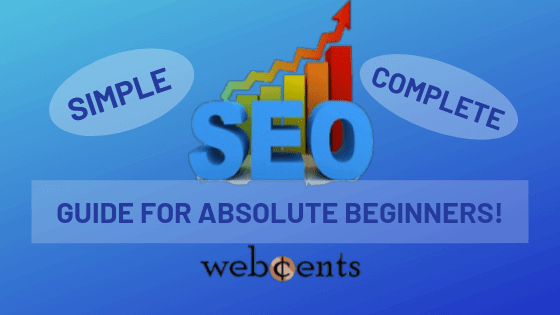If you would like to learn what SEO (search engine optimization) is and how you can use SEO to get free traffic to your blog, then you’ve come to the right article.
Now, here’s the thing about these other people who talk about SEO, whether on YouTube or on a blog. They either over-complicate it or over-simplify it.
This article is going to be different. I’m going to give you everything you need to know as a beginner at SEO, explained in simple terms. I will go over how SEO works and show you the actionable steps you can take to get free traffic with SEO.
And, without further ado, let the guide begin!
What Is SEO?

Here’s a quick overview of what SEO is.
Search engine optimization (SEO) is the work you do to your blog to make it appealing to search engines and search visitors. The goal of SEO is to target keywords that relate to your blog and rank close to the top of the search results for those specific keywords. The closer you are to the top, the more search visitors will find you and click on your content.
Let’s say John has a blog article that he just created and doesn’t have visitors. His article is written around a certain keyword that hundreds of people are searching for. He optimizes it to make his content look good to search engines and visitors.
After a month or two of work, he realizes his article is getting 100 visitors a day because they found his article on the search engine after they entered a keyword that his article could solve.
How Does SEO Work?
To understand how SEO works, you need to understand how search engines work. The first step is indexing where search engines like Google crawl the World Wide Web for websites to add to its index, which is a database of website pages and blog articles used by Google.
Next is crawling: Google bots (also known as spiders) look through your site regularly to see if your content is optimized and worthy of ranking for specific keywords.
Then, if Google notices your content is relevant to a keyword and it sees you as an authority in your niche, it will list your website for that keyword. It may decide to rank you higher over time if you create more content or improve your content.
Pros and Cons of SEO

Now, to give you a better idea of what SEO can do for you, here are all the pros and cons of using SEO to get traffic:
Pros of SEO
- SEO gives you targeted traffic, meaning that people who have the problems your content can solve will search your keywords, discover your content, and get value from it. This kind of traffic will be your most loyal traffic and you can eventually make money from them by selling them valuable products and turning them into customers.
- You have control of your SEO. You own your content, so you can do whatever optimization you would like to do with it. And, by doing it the right way, you can get more search traffic. You don’t have to depend on other websites to get traffic.
- It’s pretty simple to do SEO. As I will show you in this article, there are simple things you need to do to your content to improve your SEO. There really isn’t too much technicality inside of SEO. All you do is learn how to do SEO and simply do the work.
Cons of SEO
- It takes a lot of time. Search engines like Google take their good old time when it comes to discovering, analyzing, and ranking your content. In addition, you probably won’t be good at SEO at first, but if you can quickly find opportunities to create or improve content, get down to work. Getting traffic is really an investment. Where advertising is a money investment, SEO is a time investment.
- There is competition. SEO is really a race to the top of Google. There are other blogs and sites just like you that want to get that top spot. The key here is to either join the competition and go all in with your content, or avoid the competition and find less competitive keywords.
So, if you’re willing to accept the cons and are excited to get started with SEO, keep reading! It’s time to learn the pillars of SEO!
The Pillars of Good SEO
Now I understand that there’s a lot that goes into SEO. In this section, I’m going to explain to you the pillars of good SEO that you need to know as a beginner.
As long as your content follows these SEO pillars, you should be able to have enough SEO knowledge to rank some of your content and get SEO traffic.
With that being said, here are the three pillars of good SEO:
- Relevance
- Authority
- Engagement
Pillar #1: Relevance
This is the first and probably the most important SEO pillar. Relevance is all about giving your visitors what they want through your content.
For example, if someone wants to know the “best cooking training websites”, they want some ideas of websites they want to visit in order to learn how to cook.
If they visit your site, hoping for “best cooking training websites” and notice your content isn’t mentioning a single website to check out, they will get turned off, leave your website, and find a different website that can help them instead.
Relevance is important to good SEO! When your content is relevant to your readers, they stick around, trust you, and enjoy your content.
Here are the steps you should take to show relevance:
- Do some keyword research
- Optimize your content
- Get straight to the point
1. Do some keyword research

This is the first step to any SEO work: doing what’s called keyword research.
The goal here is to find what keywords (search terms) inside your niche you can create content for. People enter keywords on search engines like Google because they have problems they would like to have solved. So they expect to find a good website or YouTube channel that can give them ideas to solve their problems.
To help you do keyword research, I have a step-by-step article on how to do keyword research right here.
Remember the Competition
Now you can’t choose any keyword inside your niche to create content on. What you need to realize is there are many other websites and YouTube channels trying to rank for the same topic. We call this competition because everyone is basically competing for the same general topic.
So the key here is to keep your topic very, very specific, by using long-tail keywords. Instead of ranking for “how to lose weight”, try to be more specific like “how to lose 50 pounds in 30 days without exercise.”
There are fewer people trying to rank for the long-tail keyword rather than the general keyword “how to lose weight.” This gives you a better chance at ranking for that keyword.
You can use keyword research tools to help you get an idea of how many people are trying to rank for certain keywords.
2. Optimize your content
After you find your keywords, you need to create and optimize your content around those keywords. You don’t need to mention the exact keyword you want to rank for inside your content. All you have to do is keep your topic relevant to the keyword you want to rank for. Here are two ways to optimize your content for your chosen topic:
- Choose an attractive SEO title and meta description. If you were searching for that keyword, what kind of title and description would make you want to click your article? Use that for the title and description of your article. (You can use power words like “free”, “best”, “for beginners”, or even a number to grab people’s attention)
- Repeat the problem at the beginning of your article. By starting off your content mentioning your reader’s problem to them, they will realize they came to the right place and continue reading.
3. Get straight to the point
Remember the most important thing about relevance is to give the reader what they want! Do not bore them with things they don’t need to know or technical jargon that can drive them away. Keep your content simple and to the point!
When you write an article on the best websites for cooking training, tell your reader that your content will be all about showing the best websites to learn how to cook, and then mention each of those websites, giving a little detail on each of them.
Pillar #2: Authority
Another good SEO pillar is authority. By having authority, you look like you are knowledgeable about the topic you are covering. You also give off a friendly and professional vibe that can get your readers to trust you more.
There are many bloggers and YouTubers that explain how to do something by just giving the steps and then leaving them at that. When you have authority, you link out to sources that make your information look legit, and you provide enough details to convince people to believe you and what you have to share.
Here are a couple of steps you can take to improve your authority:
- Work on your content regularly
- Share websites with further information
1. Work on your content regularly

To show search engines and visitors that you are serious about your blog and want to present yourself as an authority, you need to keep working on your content!
There are three ways you can work on your blog every single day to build authority: creating more content, improving older content, and promoting your content.
You can choose to create new content frequently, ideally at least once a week. Of course, make sure your content is the best at helping your search visitors. You can also go to your older content and make them better, such as making them more understandable. The third way is to promote your content using YouTube or other social media networks. Here are some ways to promote your blog and get free traffic.
By continuing to work on your content, that sends a signal to Google that you are taking your blog seriously, and you could get higher ranks just because you are making your content more professional and easier to understand.
2. Share websites with further information
The next thing you should do to build authority is to simply link out to a few websites that can help your visitors learn even more.
When you share websites that contain inspiration for your content, people will realize that what you said was true as well as get deeper insight by visiting the site you linked to.
Not only that, search engines will notice the correlation between your article and the article you linked out to. The algorithm sees the connection and, with that, the article with the links could get ranked higher, as it’s seen to be more credible.
Pillar #3: Engagement

The last pillar of good SEO is engagement, meaning you give your visitors a good experience while they’re in your content. It’s like when you host a gathering at your place. You don’t let the guests do whatever. You need to keep them engaged!
By keeping your audience engaged, search engines will see people are staying longer inside your content and take it as a positive signal to rank your content.
Here are some ways to keep readers engaged with more value:
- Improve your site for speed and mobile devices
- Add videos and illustrations
- Connect with your audience
- Link out to more of your content
I also have some tips to help you write a great blog post. If you follow these tips, you can keep readers engaged with what you have to say in your content.
Improve your site for speed and mobile devices
The easiest way to lose your search visitors is to annoy them with a slow-loading website or a blog that is too small for them to read on their smartphones.
You should think about improving your website’s speed and usability on mobile devices. Here are a few ways you can do that:
- Change your site’s theme to a mobile-friendly and SEO-friendly one
- Remove WordPress plugins that you don’t need
- Use a plugin like Jetpack to keep your site’s images from slowing your site loading down
Add videos and illustrations
Think about if you went to a website with nothing but text, text, and more text! Boring! This is why you should add visuals to your content. Embed relevant YouTube videos (it can be yours or someone else’s) and/or add images to illustrate your point.
You can find free images to use legally on sites like Pexels and Pixabay. If you’d rather use search engines to find your images, make sure to filter the images by Creative Commons license or by “free to reuse” so you don’t steal others’ images.
Or, if you are good at designing illustrations, that’s a plus! You can use Canva.com to create a design that illustrates what you have to say.
Visuals like these are a great way to slow your readers down a little and keep people engaged in your content.
Connect with your audience

Probably the best way to keep your audience engaged in your content is to actually connect with them. By interacting with them at a closer level, you can build a stronger connection with them and keep them loyal to you.
Here are some ways you can connect with your audience:
- Add a comment section. It’s easy to do this in WordPress.
- Take the time to reply to every user that comments on your content. If they have a question, answer it. If they compliment, thank them.
- Consider sharing your content on social platforms like YouTube, Facebook, Pinterest, etc.
Link out to more of your content
Remember that I told you to link to other websites in order to build trust and authority? The other reason you link to other sites is to give your readers more insightful content to consume.
But you have more content of your own, so why not share them?
As you are writing your article, if you mention a topic you went through in a previous article, share a link to that article. That way, if there is something you say that interests your reader, they will have a link to click to satisfy their curiosity.
Final Words
Allow me to wrap up this article by sharing with you some free, awesome SEO resources that I think you should check out!
Free SEO Tools
- Google Search Console – This tool offered by Google can give you information about your website’s impressions (people who saw your site in the search) and search clicks, as well as useful SEO stats to help you understand how your blog’s SEO is doing.
- Ubersuggest – With this website, you can do keyword research and get a better understanding of how competitive keywords would be. You can even create an account to track your site’s SEO progress.
- Yoast – This WordPress plugin can help you improve your SEO content and give you the ability to optimize your SEO title and description. You can find other WordPress SEO plugins here.
Free SEO Blogs and Websites
- Neil Patel – This SEO genius knows his stuff and he’s got a ton of content for you to help improve your SEO, even if you’re a beginner! He also has an SEO-themed YouTube channel with thousands of videos for you to learn SEO with.
- RankYa – In this blog, you will learn SEO secrets to help get the most out of SEO. Be sure to check out the RankYa YouTube channel as well.
Of course, you can check out my articles around SEO and getting traffic here.
Conclusion
And that will do it for my complete beginners’ guide to SEO. I hope this article gave you a better understanding of how to use SEO to get free traffic to your content.
I also hope this inspires you to TAKE ACTION. All the knowledge in this article won’t do you any good unless you actually APPLY the ideas that I gave you in this article.
With that being said, I believe in you. Do the SEO work and free traffic will come!

